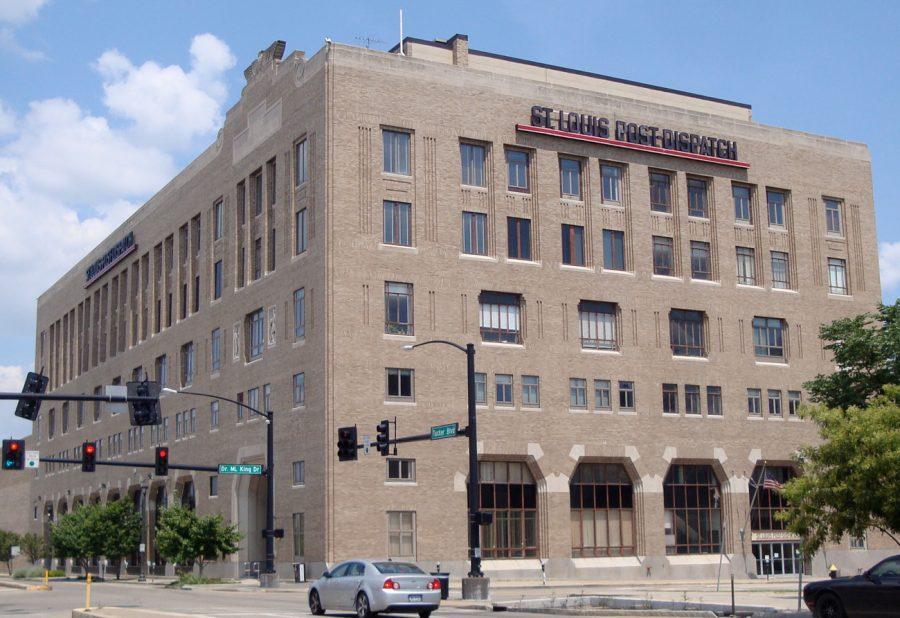Post-Dispatch building resonates with memories
Published August 8, 2019
I’ve said my goodbyes to the St. Louis Post-Dispatch.
Not to the newspaper, but to the building at 900 North Tucker Blvd. where the paper’s essence has come to life and taken shape for the past 60 years, a third of them with me working in it.
This month, the paper plans to leave the six-story, 235,000-square-foot structure with two basement levels and four parking lots and start doing business from 50,000 or so nearby square feet spread over 2½ floors at 901 North 10th St. With some luck and a stiff westerly breeze, a baseball hit hard from the roof of 900 North Tucker could break a window on the backside of 901 North 10th.
News that the paper’s owner, Iowa-based Lee Enterprises, was selling the Post-Dispatch building to StarLake Holdings in Clayton broke a year ago, almost to the day. They completed the transaction barely a month later.
The deal initially had the Post-Dispatch staying in the Tucker building and operating out of its top two floors, but that idea crumbled pretty quickly. Instead, Lee announced in early January that the paper would lease the second and third floors of 901 No. 10th, which StarLake coincidentally had bought one month earlier. It had been vacant for seven years.
Opportunity, it seems, had knocked. The move was “a great opportunity to improve our work environment,” wrote Post-Dispatch Publisher Ray Farris in an e-mail to employees announcing the deal.
It is “a great opportunity for the Post and for us as building owners,” echoed StarLake’s John Berglund, its co-founder, chief executive and managing partner. StarLake’s principal co-founder is Jim McKelvey, a successful entrepreneur and St. Louis native.
Opportunity notwithstanding, the fact that the paper is actually abandoning its building on Tucker hit me like a shock wave.
From the time I was old enough for my bar mitzvah, that imposing building on the northwestern edge of downtown has been home to the paper I grew up reading, admiring and respecting long before, by some miracle, I joined the staff and spent 22 years coming to know the paper well enough to love it.
When I tried to picture 900 N. Tucker without the newspaper inside, it felt wrong, like I was losing something important, like when you think about the house or apartment where you grew up, long after it’s been sold or rented to strangers. At that point, I knew I needed to get back inside for a last visit before the newspaper left.
I managed to do that a month or so ago, escorted by a patient friend who still works there.
It was instantly familiar and comfortable. And not just the features area on the fifth floor, where I reported and wrote about consumer news and then television for 16 years, and the editorial areas on the fifth and second floors, where I worked for nearly six years as editor of the commentary page and an op-ed columnist.
The fact is, there weren’t many places in the building where I hadn’t spent at least some time over 22 years, and on that final visit, I roamed pretty much everywhere that wasn’t off limits because of demolition or renovation.
It was a wistful visit, to be sure. There was no way I could walk through the building and not remember the human decency I experienced there with good people I had the good fortune to do good work with.
There they were in my head: endlessly resourceful clerks in the news, features and editorial departments; skeptical snoops in research (the “morgue”); copy editors who never hesitated to argue with me and who rescued me from too many mistakes I should have caught but missed.
There, too, were my colleagues: reporters, columnists, editors, photographers and artists … furiously idiosyncratic men and women who blended, in seemingly limitless variations, brilliance, creativity, goofiness, skill, dedication to principle and dedication to unpredictable humor.
These people — each in his and her own way — set high standards for me, gave me chances to excel, corrected me, protected me, took risks for me and helped make me a better professional journalist than I ever could have become without them. It all happened in the building on Tucker.
Something else struck me on my visit: the emptiness of the place, the fifth-floor newsroom in particular, and the quiet that accompanies a scarcity of people.
The sad truth is that, like all too many newspapers in 2019, the shrunken, overworked staff of today’s Post-Dispatch doesn’t need 235,000 square feet of space on six floors. Yet they still somehow manage to uncover, sort out and reveal to us important truths about our community, our institutions and our fellow humans. Maybe not as often as they used to and surely not as often as they want to, but what they do is nonetheless no small miracle and one we appreciate less than we should.
If any single feature of the building on Tucker embodies the identity and heritage of the St. Louis Post-Dispatch it is two pieces of writing by the newspaper’s founder, the original Joseph Pulitzer. They are spelled out in metal letters affixed to adjacent marble walls in the building’s lobby.
One is a quote from an essay Pulitzer wrote for the North American Review journal in 1904, in which he assigns to future generations of journalists the responsibility to “preserve that public virtue without which popular government is a sham and a mockery.”
The other is a brief reflection that he wrote on April 10, 1907, to mark his retirement and that came to be known as the Post-Dispatch Platform. It is a declaration of principles, a kind of Ten Commandments — five “Thou Shalts” and five “Thou Shalt Nots,” though not in those words — for his newspaper and, indeed, for journalism itself at its best. The Platform appears every day in the print edition of the newspaper at the bottom of the editorial page, and its 82 words invariably are the best thing in the paper.
I asked Post-Dispatch Editor Gilbert Bailon if these two defining installations will move with the paper this month to 901 No. 10th Street. They will not, he said. The building’s new owner, StarLake Holdings, intends to preserve them, he said, as historical features of the building.
However, Bailon said, in preparing for the sale and move, workers had found in storage a large metal sculpture bearing the words of the Platform. It’s 4 to 5-feet wide and 3 to 4 feet high, unimaginably heavy and actually predates the version in the lobby on Tucker. It originally hung on a wall at 1139 Olive Street when that was the Post-Dispatch headquarters.
That sculpture will be installed at the newspaper’s new offices on 10th Street, Bailon told me.
When I left the Post-Dispatch, I walked over to take a look at the new building. The interior, however, is undergoing top to bottom upgrades of all systems and is closed to non-workers.
From the street, though, it’s a puny-looking thing, something you might see in a thousand industrial-park developments. It conveys no sense of significance or authority, whereas the massive Tucker building conveys nothing but significance and authority.
Installation of the oversized metal sculpture of The Platform, therefore, will be the most important upgrade to 901 No. 10th, new home of the St. Louis Post-Dispatch.
Eric Mink is a freelance writer and editor and teaches film studies at Webster University. He is a former columnist for the St. Louis Post-Dispatch and the Daily News in New York. Contact him at [email protected].

















